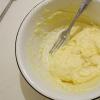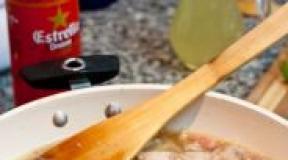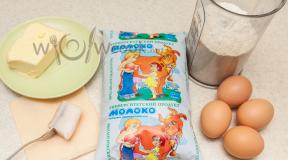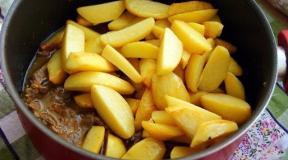When to add salt to soup. How to cook broth: a complete guide
Salt is an essential food additive that has long been present in the human gastronomic world. Despite modern contradictions between benefits and harms, it is rarely possible to completely eliminate it from the diet. It is almost impossible to prepare a delicious soup without salt, because it adds an interesting taste to the dish. But what to do if you over-salted the soup and how to salt it correctly to avoid this?
Unfortunately, there is no universal rule, since much depends on individual preferences. However, some general rules still exist:
- Most dishes are recommended to be salted at the last stage of cooking;
- Solyanka is salted in small quantities, since it contains salty components;
- Before testing the dish for salt, it must be cooled, otherwise it may seem less salty;
- When checking a soup for salt, just taste the broth;
- try the dish no more than twice, otherwise sensitivity to salt may become dulled and you won’t notice the saltiness;
- salt from different manufacturers may have different concentrations, so it is better to choose a specific brand and use only that one.
What to do if you over-salt your soup?
Depending on the type of soup, the method for solving the problem may differ. To avoid confusion, you can use the following recommendations:
- Soupwith vermicelli can be corrected by adding a bag of rice or flour for 10 minutes.
- What to do if you have over-salted cabbage soup, borscht, solyanka or tomato soup? Just add a small amount of lemon juice or apple cider vinegar.
- You can throw a handful of rice into the pickle or green cabbage soup or add a raw egg.
- Adding tomato paste or sour cream will help with the problem with any “red” soup.
- Lemon will perfectly correct fish soup and solyanka.
- Soup-Mashed potatoes can be saved by adding cream.
- Bean, chicken, mushroom or pea soup will be improved by adding a raw egg.
- The excess salt will be absorbed by the peeled potatoes. If the first dish is thick enough, the “auxiliary” potatoes can be removed and used as a side dish or added to a salad. In empty soup, you can simply mash the potatoes and leave them.
- Cereals such as rice, buckwheat or millet absorb salt perfectly. The cereal must be wrapped in gauze and placed in a pan. The bundle can remain there until completely cooked.
- Chicken eggs are great for fixing heavily salted fish soup or other fish dish. The egg is broken into a bowl, mixed and carefully poured into the soup. What to do if a liquid dish with boiled eggs is not eaten in the family? You can simply remove them with a slotted spoon before serving.
- Instead of cereal, you can add wheat flour, wrapped in clean gauze or cloth, to a pan with over-salted soup. After some time, the bag is removed. The disadvantage of this method is the appearance of turbidity in the broth.
How to properly salt various dishes
Different dishes require different amounts of salt, but at what stage should food be salted and in what amount?
Soups
It is better to salt the soup when all its components are cooked. In a three-liter saucepan, 3 teaspoons of salt are enough.
Meat
The meat does not require much salt because it is not completely bland. This is what causes problems during cooking. A teaspoon of salt is needed per kilogram of steak cooked over an open fire; half a teaspoon is added per kilogram of baked meat. How much salt do you need per kg of minced meat? Half a teaspoon is enough.
Fish
Fish is not salted like other products. Before you start cooking, you need to rub it with salt. Per kilogram you need 3 teaspoons. When it comes to preparing fish soup, it is better to add 4 tablespoons, since some of the salt will be absorbed by other ingredients. Fish dishes are salted before cooking.
Vegetables
Salt gives vegetables juiciness. It is better to salt them towards the end of cooking, otherwise they may become tougher. When frying eggplants, it is necessary to salt the oil used for cooking. There is no need to salt the fruit itself. Boiled potatoes are salted 15 minutes after boiling. A teaspoon of salt is enough for a kilogram of potatoes.
Pasta and dumplings
Any dishes made from unleavened dough that are cooked with broth or water must be salted while the liquid is boiling. It is from the broth that the dish will absorb the required amount of salt. For pasta you need 1 teaspoon per liter of water, for dumplings or dumplings - half a spoon.
Sweet pastries
Sweet baked goods are salted to emphasize the sweetness and airiness of the dough. For sweet dough, one pinch per kilogram is enough, and for yeast dough, two. A teaspoon of salt is added per kilogram of puff pastry prepared with an oil base.
How to save dishes from excess salt
There are methods that will help you cope with the problem using products.
What to do if you oversalt your meat or fish?
Over-salting meat is a complex problem that requires some sacrifices: the taste of the dish will most likely suffer, but you will still be able to save it from the trash. The meat must be removed and washed in cold water. After this, it is kept on fire for some time.
Grilled, lightly salted fish can be treated with the addition of lemon juice.
What to do if you over-salt your mashed potatoes?
In this case, adding some unsalted mashed potatoes helps. If this option is not suitable, then you can use butter. Many people like potatoes with the addition of butter, which adds tenderness, mutes the salty taste and makes the mashed potatoes thicker.
How to fix rice?
The most suitable method in this case is to rinse with plenty of cool water. The lower the water temperature, the better the end result. Washed rice will become more attractive and will get rid of excess salt.
Correcting over-salted porridge, buckwheat and other cereals
If the porridge was prepared with milk, then you can get rid of the oversalting by adding a small amount more. Otherwise, it is better to use peeled raw potatoes, which will absorb excess salt.
How to avoid oversalting
There are several small tricks that will help you avoid repeating mistakes in the future:
- taste food while cooking, but not too often, once or twice is enough;
- study the components of the dish in advance for its salt content;
- remember: you can always add salt to taste, but it’s less common to save soup and other dishes from over-salting!
Everyone seems to know that this is how it should be done. And no one does. Oh, in vain.
This is what the salt norm per day looks like for each of us - 5-6 g:
And this is what the portion we consume daily looks like:

It's very simple to explain: we don't know how to salt food.

Remember:
Undissolved salt penetrates the product rather slowly. Therefore, salt crystals from the surface of food fall directly onto the taste buds of the oral cavity and cause the sensation of saltiness of the food. To salt the entire dish to the same taste would require significantly more salt.
Salt dissolved in water (broth, decoction) is absorbed faster and more intensely by foods, which means more of it is required. Salt the soup immediately before eating - reduce the amount of salt significantly.
Iodized or sea salt loses iodine during heat treatment. If you want to preserve nutrients, add salt to food before eating.

Salt complicates the cooking process and even spoils some foods!
In the presence of salt, the cell membrane of some products thickens. This makes it difficult for them to become soft during cooking. Therefore, solid foods (for example, beans) in salt water are cooked through longer heat treatment. It is very difficult to boil even ordinary potatoes in sour cabbage soup until soft. And meat or liver salted at the beginning of cooking will always be tough.
Salt inhibits the process of softening the gluten of flour. Therefore, salty baked goods are not so porous, fluffy and soft. Although a small amount of salt helps maintain the shape of the product. Because of this, the spice is added a little to all flour products, even sweet ones.
The presence of salt slightly increases the boiling point of the liquid. Those. foods in a salty solution will cook at temperatures exceeding one hundred degrees Celsius. This should be taken into account when strict temperature conditions are required, for example, when preparing porridge or stewing.
Salt helps to release juice from food. This can only be useful if the juice of the product is bitter and it is better to remove it before cooking (for example, this is what you do with eggplants). Salads should be salted immediately before serving, and fried meat should be salted only after a golden brown crust appears.
Salt is absorbed more evenly into an almost finished product than into a raw product. Therefore, adding spices at the end of cooking ensures that all parts of the dish taste the same.
During heat treatment, especially long-term cooking, the volume of the dish changes due to the evaporation of liquid. When adding salt at the beginning of cooking, there is a high risk of oversalting the dish. When the food is almost ready, it is easy to estimate the amount of salt needed for the final product.
How to salt food correctly? The question is not idle. After all, like any spice, you can not only improve a dish, but also completely ruin it. My grandmother, Anna Nikolaevna, said: “You know how to salt, you know how to judge.” From time immemorial there have been culinary rules: when and how much to salt. Let's remember them.
Rule one
Any liquid or semi-liquid dishes prepared with water should be salted only then , when they are completely ready, because food absorbs salt more evenly at the end of cooking.
The meat broth is salted 20-30 minutes before the end of cooking, so it will become transparent.
Vegetable soups - 10 minutes before the end of cooking.
Mushroom broth - at the very end.
Legumes(beans, beans, lentils, peas) are salted after cooking. If you salt them at the beginning, they will cook for a very long time.
However, from this rule there is exceptions: If you cook cereals, pasta, vermicelli, dumplings, dumplings, dumplings, as well as fish, fish soup or vegetable broth, then you need to salt the water at the beginning of cooking. In this case, the water boils faster.
Rule two
Meat should be salted very moderately; it already contains various salts. The delicate taste of a meat dish and its pronounced smell are preserved only with moderate salt consumption.
If you stew meat, you need to salt it 10 minutes before cooking, otherwise it will be tough.
When frying, pieces of meat (langettes, entrecotes, escalopes) are salted only when a golden brown crust has formed on them (usually 3 minutes before the end of cooking, otherwise they will be dry).
Meat dishes cooked on a spit are salted just before the end of roasting.
The liver is fried unsalted, otherwise it turns out too tough.
Rule three
Fish (either boiled, fried, or stewed), you need to salt it generously.
To make fish with a soft consistency firmer, it needs to be salted an hour before frying.
If you are going to fry or stew fish, then it is better to salt and pepper it raw 10-15 minutes before cooking, then it will not fall apart during the frying process.
Fish for baking in the oven is salted 5-7 minutes before cooking.
Rule four
Potatoes are salted differently, depending on how they are prepared.
Boiled potatoes, peeled, are salted as soon as the water boils.
Jacket potatoes are salted at the very beginning of cooking (if salted at all).
It is better to salt fried potatoes when they are almost ready, otherwise the slices or strips into which the potatoes are cut will fall apart.
If potatoes are boiled for mashing, then they add salt at the end of cooking, then it will be tastier.
Rule five
When frying vegetables, salt is added at the very end, otherwise the vegetables turn out stewed.
When frying eggplants, salt the pan, not the vegetables themselves - this makes it almost impossible to over-salt them.
Raw salads are salted before serving, otherwise the juice will stand out, the taste will deteriorate, and the dish will be unappetizing.
As you can see, salting food is an art.
If you also know the rules of this art, tell us about them and remember that under-salting is on the table, over-salting is on the back.
Solid, serious cookbooks very often open with broth recipes. The reasons are not difficult to guess: broths are the basis of cooking, without which warming soups, aromatic sauces, creamy risottos, clear jellies, and many other dishes that make up a significant part of the treasury of world cuisine are impossible. A modern city dweller is in a permanent state of time pressure, and there is a great temptation not to bother with cooking broth, but to dissolve a bouillon cube in boiling water, but this compromise is best left to those who do not particularly care about the contents of their own plate. The point is not even that it is “chemistry” - just try it, and you will unmistakably distinguish a broth from a cube from a broth cooked according to all the rules of culinary science. What does it mean? This means that everyone who wants to learn how to cook must definitely master this simple science - preparing the perfect broth.
Types of broths
Broth is a decoction of meat, fish or vegetables; when properly prepared, it has a pleasant and rich taste (as well as healing properties, although that’s not about that now). Broth can be a dish in itself, but most often it is used as a foundation, an intermediate link in the preparation of other, more complex dishes. We have already listed the main ones in the introduction to this article, and it should also be noted that broth is an excellent base for cooking: meat or fish cooked in broth (meat or fish, respectively) retain a rich taste and aroma, and rice and other The cereals turn out very tasty.
As a rule, broths are made from bones, sometimes with some meat, and with the addition of vegetables and aromatic herbs, but there are many recipes for vegetarian broths. Historically, different types of broths appeared in different parts of the world, so it is quite difficult to classify them into any single classification. Here are the main types of broths:
- the basis of the basics. Chicken broth is so versatile that it is ideal for most soups, sauces and risottos, and the neutral flavor of chicken broth makes it easy to use in fish and seafood dishes.
- from beef, pork or other types of meat. This broth is an excellent base for hearty soups and sauces for meat dishes.
- boiled from bones, as well as heads and fins of fish, used for making fish soup and fish soups, as well as for boiling fish, which makes its taste more rich.
— cooked from vegetables and herbs without adding meat. This broth is quite aromatic and can be used as a complete replacement for chicken or meat broth when preparing meatless and vegetarian dishes.

Mushroom broth- prepared from mushrooms, dried or fresh, and used to make mushroom soups, risotto, etc.
- a light broth based on kombu seaweed and dried bonito tuna shavings, a base for miso soup and other Japanese soups.
Low Soy- Chinese soybean, reusable, in which meat is cooked, after which it is not poured out, but left until next time. Gradually, this broth is enriched with the taste of the products cooked in it and, if handled correctly, can be stored almost forever. They say that some Chinese chefs cook in broths that are hundreds of years old.
In addition, you can highlight a broth made from seafood (quite common in places where seafood is plentiful and they cost pennies), a broth made from the shells of shrimp and other crustaceans (an excellent base for chowder and other dishes that involve shrimp) and other very exotic ones. types of broth. They all have one thing in common - the cooking method, so let's understand the theory of preparing broth.
Broth ingredients
Broth, like any dish in general, begins with the selection of ingredients. I have already mentioned many of them above, but I forgot about the most important one. Let's start with it.
Water
Water is something without which no broth is unthinkable, so use high-quality, tasty water without foreign impurities to prepare it. During the process of cooking the broth, the water will boil away, but if you add water to the broth to replace what has boiled away, this will negatively affect its taste. For this reason, water is always taken a little more than the amount of broth that needs to be obtained. Well, if something goes wrong and you have no other choice, add boiling water rather than cold water so that the cooking process does not stop.
The basis
The basis of the broth is usually bones, meat or fish. Bones are used because they are very cheap but make a wonderful broth, so ideally the bones should be chopped to make the broth richer. Often the broth is cooked not only from bones, but also from meat - this is justified if you are preparing a soup in which this meat will be an integral part, but for all other cases this is not the best idea: the meat will inevitably “give” part of its taste to the broth (this is why it is better to cook meat not in water, but in broth).
If the broth is prepared from fish, in addition to bones, fins and heads are usually used: in this case, the gills must be removed. In addition, I have come across recommendations to remove the eyes so that the broth does not become bitter, but I almost never do this, since in practice the difference in the taste of the finished broth is hardly noticeable.
If you are preparing vegetable broth, the following ingredient serves as the base.

Vegetables and roots
Even if you cook broth from meat, roots and vegetables cannot be neglected - this is the most important component of the broth, which gives its taste richness and depth. Traditional candidates for adding to broth include onions, leeks, garlic, carrots, stalks of celery, and celery and parsley roots. Other vegetables that can be added to the broth, especially if you cook it only from vegetables, are tomatoes, bell peppers, fennel, parsnip root, as well as mushrooms, which do not seem to be vegetables. When cooking Asian broths, in addition to those listed, roots or galangal can be used.
Bouquet garni
If this name is unfamiliar to you, do not be alarmed: the French term “” refers to a bouquet of fragrant herbs that are added when cooking broth or stewing meat to flavor the broth or sauce and, more generally, herbs and spices in general that are added to the broth. The main herbs that are used when cooking broth are parsley, thyme, bay leaf, rosemary, leeks and others; the main spices include black and allspice and cloves. Before adding herbs to the broth, it is convenient to tie them into a small bouquet, which is easy to remove from the finished broth, and put the spices in a gauze bag for the same purpose. I wrote in one of my previous articles.
Making the broth
In this section, I decided to combine all my knowledge about the various nuances of preparing broth, but, of course, it does not pretend to be encyclopedic accuracy. Corrections and additions in the comments are more than welcome.
About the benefits of stocks
Classic culinary school teaches that food waste should be kept to zero, and broth is an ideal way to recycle leftovers that would otherwise end up in the trash. If you are going to cook - cut off the third joint - save the bones, done - do not throw away the green part, cooked - do not rush to get rid of the stems. All this, not to mention the onion and carrot peelings, will become the basis for an excellent broth, and if you make it a habit to freeze the leftovers and regularly boil the broth as they accumulate, your life will become easy and cloudless.
Slicing ingredients
In order for the ingredients to impart their taste and aroma to the broth as quickly as possible, they must be chopped. For these purposes, it is better to chop or saw the bones, and cut the vegetables into several parts. The rules for preparing a classic French broth require finely cutting mirepoix, but in your home kitchen you can simply cut each vegetable into several parts. Cut the onion into 2 or 4 parts and that will be enough.

Pre-roasting
If all the ingredients are added raw to water, the result is what is called white broth. For red broth, which has a richer flavor and aroma, as well as the color from which it gets its name, vegetables and bones are pre-fried. To do this, you first need to chop them (slightly larger than for white broth), and then fry them in a frying pan or bake them under the grill until golden brown and sometimes charred: the grill method seems preferable to me. After this, the broth is boiled as usual.
When to salt the broth?
From time to time you can come across two recommendations for cooking broth, which almost contradict each other. First, the broth needs to be salted at the end. Second - if you want boiled meat, add salt at the end, if you want broth, add salt at the beginning. Who to believe?.. Both theses are not without foundation - on the one hand, the broth will boil away, and if you salt it at the beginning, you can seriously miss it, on the other hand, it helps to “pull out” aromatic substances from the ingredients. Therefore, I do this: I literally add a pinch or two of salt at the very beginning of cooking the broth, and finally salt it at the end. This is a universal technique, which, however, must be used with caution if you are cooking broth for a sauce, which you then plan to boil several times - in this case, it is better to salt not the broth, but the already prepared sauce, so as not to over-salt it.
First water
Another common recommendation is to drain the “first water,” that is, fill the bone with water and bring it to a boil, drain the resulting broth, add new water, and only then begin cooking the broth itself. The arguments in favor of this approach, it must be said, do not sound entirely convincing: supposedly the first water takes away most of the harmful substances contained in meat and almost hormones with antibiotics, but I have not read about at least one serious study on this topic. In some cases (for example, when cooking broth from pork knuckle) this method really has a right to exist, in others I don’t use it. I leave the final decision up to you, especially if you are cooking for children.

Removing foam
As the water approaches the boiling point, a repulsive foam appears on the surface of the future broth, which is usually removed with a spoon or strainer. This foam is nothing more than the protein contained in meat and bones, which, under the influence of high temperature, undergoes denaturation and rises to the surface. There is nothing harmful or dangerous in it, so the foam is removed primarily for aesthetic reasons: if this is not done, the foam will separate into small particles, which will make the broth more cloudy. As a rule, the more foam is formed, the hotter the water boils, so if you properly regulate the heat under the pan, its amount will be minimal. That is why the easiest way to cook broth that is as clear as a tear without any extra hassle is to do it in a slow cooker: this is the very case when the use of this device is more than justified.
Straining the broth
The finished broth is filtered using a colander and, preferably, gauze folded in several layers. Valuable advice that I learned from smart books: after straining the broth, do not rush to throw away the contents of the colander, but press it properly with a slotted spoon. This way you will get a few more drops of broth, the most rich in taste and aroma.
Clarifying the broth
If you didn't skim the foam very well or cooked the broth over too much heat, it will turn out quite cloudy. There is nothing wrong with this, but a number of dishes, primarily soups, require the use of clear broth (for, again, aesthetic reasons). For these purposes, the finished broth can be clarified. The simplest way that I use for this (it must be said, not often) is to beat two egg whites, add to the slightly cooled broth, bring it to a boil again, skim off any foam that appears and strain through cheesecloth. There are also more ingenious ways to clarify broth, in which, along with whipped whites, crushed eggshells, minced meat, ice, or even pressed caviar are used, which was used to clarify broth in pre-revolutionary Russia. Those interested can find information about these methods on their own.

Fat removal
It seems like everyone knows about this, but still. The easiest way to remove as much fat as possible is to put the finished, strained broth in the refrigerator. Under the influence of low temperature, the fat will rise to the surface of the broth and harden, after which it can simply be skimmed off with a spoon.
Freezing broth
It often happens that you need all or part of the cooked broth not right now, but in the distant future. The broth can sit in the refrigerator for a couple of days, but if you plan to use it later, it is better to pour the broth into plastic containers or bags and freeze (label the container if you store several different broths in your freezer). A more sophisticated way is to boil the already strained broth several times, cool and freeze in an ice container. The resulting “broth cubes” can be used as needed to prepare soups, sauces and other dishes.
Recipes
I think that this will be enough theory and we can move on to practice, that is, actually, to cooking the broth. All the recipes given here are universal - they can be used to prepare any dishes, if necessary, adjusting the broth recipe to your taste and according to plans for its further use, for example, a rich gravy for lamb can be prepared by cooking lamb bone broth according to the red broth recipe and boil it several times until thick.
Chicken bouillon

Low
10 minutes + 3 hours
Ingredients
1 kg. chicken bones or bony parts of chicken
1 onion
1 carrot
1 stalk of celery
3 cloves garlic, unpeeled
a few sprigs of parsley
1/2 tsp. black pepper
The smartest thing to do is freeze the bones every time you cook and cut up chicken, and when you have enough of them, place them in a saucepan, add water and bring to a boil. Just before boiling, foam will begin to appear on the surface of the water - remove it, and then add coarsely chopped vegetables, parsley and peas. Simmer the broth over low heat for 3 hours, skimming as needed, salting the broth shortly before it's ready, and straining it after removing the pan from the heat. If you bake chicken bones in the oven until golden brown before cooking, you can cook red chicken broth in the same way.
White beef broth

Low
10 minutes + 4 hours
Ingredients
1 kg. beef or veal bones
1 onion
1/2 leek
1 carrot
1 stalk of celery
3 cloves garlic, unpeeled
100 g celery root and parsley
a few sprigs of thyme and parsley
2 bay leaves
1/4 tsp. allspice
1/4 tsp. black pepper
3 cloves
Pour water over the bones, place over medium heat and bring to a boil. Shortly before boiling, start skimming, then add coarsely chopped vegetables, herbs and spices. Simmer the broth over low heat for 4 hours (or longer), skimming as needed, salting the broth shortly before cooking, and straining it at the end.
Red beef broth




















